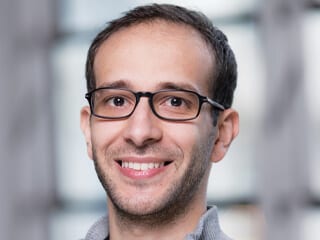
Latest News
The latest recipient is Mohamed Koronfel (Imperial College), for his work on “Understanding the reactivity of CoCrMo-implant wear particles”, published in Nature|Materials Degradation (doi:10.1038/s41529-018-0029-2)
The Galloway Award requires students to simply send a copy of a submitted or published paper from the previous 12 months, rather than a separate technical report. The student must be the primary author of the work and preferably first author.
CoCrMo alloys have been considered as an attractive material for orthopaedic implants due to their high wear and corrosion resistance. However, in practice, the release of millions of wear particles per patient annually led to high failure rates of CoCrMo Metal-on-Metal hip implants. These wear particles invoke an inflammatory response in the patient, where immune system cells (macrophages) are recruited to attack the wear particles. The inflammation comes with an associated severe pain that often leads to revision surgery and implant removal (failure). Due to the unexpectedly high failure rates, lawsuits were filed in both the UK and USA against the implants’ manufactures. Furthermore, due to unknown long-term effect of these wear particles, clinical risks to patients may manifest even long after revision surgery. The macrophage cells, where wear particles were typically found in vivo, create a harsh acidic, oxidising environment which may lead to the release of potentially toxic and carcinogenic metal ions.
A number of studies characterised the state of wear particles inside macrophages in periprosthetic tissue (accessible after implant removal during revision surgery). Although CoCrMo alloys are nominally an extremely stable material and contain very high levels of Cr (Co 60 % : Cr 30 % : Mo 7 %), the post-surgery wear particles were composed mainly of Cr and only trace amounts of Co. This high-level of Co dissolution is unexpected given the alloy’s stable Cr-rich passive film. Studies on periprosthetic tissue after implant failure provide little insight into the dissolution stages and exposure history imposed on wear particles in vivo. In order to understand the in vivo reactivity of wear particles, in situ monitoring of their chemical and physical changes in simulated biologically relevant conditions was carried out, using X-ray absorption spectroscopy and transmission X-ray microscopy at synchrotron-radiation facilities, which provide high chemical sensitivity and in-situ measurement capabilities.
This work highlights the potential reaction mechanisms that would not have been evident from the required regulatory testing regimes. Additionally, the work demonstrates the potential of synchrotron-based approaches to provide dynamic chemical information on nanoscale systems under practical conditions.
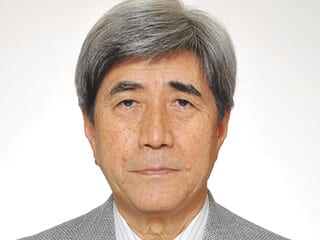
Latest News
As previously announced, this will be held on 26th-28th August 2019, as part of Electrochem 2019 at the University of Strathclyde, organised jointly with the Universities of Strathclyde (Prof. Sudipta Roy) and Glasgow (Dr Mark Symes).
Professor Tetsuo Shoji will receive the UR Evans award 2019 at this Symposium for his outstanding contributions in the broad aspects of corrosion science and engineering. His research field covers the Physics and Chemistry of Fracture, combining mechanics and chemistry that is necessary for the analysis of materials degradation and fracture mechanisms, as an extension of material strength and fracture mechanics. For example, one of the factors degrading the safety and reliability in structures and components is crack initiation and propagation under the influence of chemical environments, and its mechanistic understanding is of extreme importance. His work has been key in the development of better instrumentation and analysis, particularly in the :
n Development of a recrystallization-etch technique and a unique evaluation procedure for crack tip intense strain region, by which ductile fracture could be quantitatively analysed.
n The unique formulation of stress corrosion crack growth rate, based on a mechanistic understanding of crack growth under a mechano-chemical reaction at a crack tip. Thereby the first to establish a predictive capability of growth rate of stress corrosion cracking, taking into account both crack tip mechanics and chemistry, and;
n Establishment of a predictive model and a capable procedure for aging degradation evaluation of plant components in energy conversion systems such as fossil and nuclear power plants and plant life time prediction and management.
Also from his varied original work, he contributed to the setting up the Centre of Excellence for Physics and Chemistry of Fracture, focusing on mechano-chemical phenomena and its relevance to failure in the field of operating plants. He is one of the pioneering leaders in this research field and has published more than 500 journal papers covering atomic scale simulation of oxidation, hydrogen accelerated oxidation, mechanism-based alloy design, electrochemical materials characterization, mechanistic study of oxidation, non-destructive testing and evaluation and fracture mechanics and failure analysis.
Tetsuo Shoji served as a Professor of Tohoku University from 1986 until March 2018. He was honoured as a Professor Emeritus of Tohoku University in 2015. Currently, he is continuing his research work as a Senior Research Fellow of New Industry Creation Hatchery Center (NICHe) of Tohoku University. He is also a Distinguished Professor of the National Centre for Materials Service Safety, University of Science and Technology Beijing, USTB in China since 2013, and High -level Foreign Professor of Institute of Disaster Management and Reconstruction of Sichuan University since 2018.
Prof Shoji was a postdoctoral fellow working for Professor R.N. Parkins at the University of Newcastle upon Tyne, and a Visiting Professor at Massachusetts Institute of Technology. He was the principal investigator of various national and international programmes, such as the Centre of Excellence Programme on Physics and Chemistry of Fracture and Failure Prevention, the Co-Director both of CNRS LIA ELyT laboratory and the international Joint Laboratory of Tohoku University and USTB, and international cooperative research programme of PEACE and POLIM, working on mechanics and mechanisms of Environmentally Assisted Degradation such as SCC and Environmental Fatigue. He has received 20 national and nine international awards, including the NACE W.R. Whitney Award in 1998, the Lee Hsun Award in 2006, Chinese Academy of Science and the Great Medal from CEFRACOR, France in 2016. He was appointed by the Prime Minister as a Council Member of Science Council of Japan in 2011 for seven years and was elected as a Member of Science Council of Japan in 2018 for six years and also elected as a member of the Japan Engineering Academy.
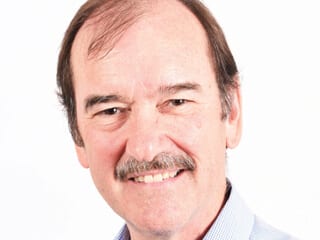
Corrosion Engineering Division, Latest News
This year’s Paul McIntyre award is going to Steve Paterson, and he will be presented with this at the up-coming Electrochem 2019 Conference being held at Strathclyde University, Glasgow.
Steve Paterson obtained a B.Sc and Ph.D in metallurgy from Imperial College, London. His Ph.D thesis investigated the mechanical and microstructural properties of aluminium alloys during indirect extrusion. He joined Shell International, and over 34 years had an exciting journey in a variety of roles involving materials, corrosion, welding and integrity management. His experience covered the research, refining, chemical and oil & gas production sectors and he worked in the UK, Netherlands, Norway and Malaysia.
Since retiring from Shell in 2017, Steve has worked as an independent consultant and is currently a part-time lecturer at Robert Gordon University where he teaches materials & corrosion, and corrosion management. His involvement in academia includes his role as Chair of the Imperial College Materials Advisory Board, and he is an adviser to the Shell-Imperial AIMS centre which was set up to develop new insights into materials behaviour particularly surface interactions at the nano-scale. He also provides training in corrosion prediction and corrosion management for Shell, and he will soon start to deliver an industry course on Corrosion under Insulation.
He was a member of the Energy Institute Corrosion Management Committee from 2006 to 2014, including Chair, and during this time was directly involved in the development of the industry guideline publications for Corrosion Management and for External Corrosion Protection. His involvement with EEMUA (Engineering Equipment and Materials Users Association) since 2003 resulted in the continuing development of the subsea materials & corrosion control guidance publication (EEMUA 194 – now at Rev.4), and the delivery of the associated training course since its inception in 2008. He co-authored the EEMUA 218 publication for quality requirements for the manufacture and supply of duplex stainless steels, and subsequently provided input to the ISO 17781 standard for testing of duplex stainless steels.
During his time at Shell he was responsible for the development of graduate materials & corrosion engineers, and from 2006 to 2017 was involved in the mentoring of over 50 young engineers. He used this experience to help the Institute of Corrosion develop its C.Eng competence matrix in 2017.
He has been a regular attendee at Eurocorr conferences where he first met and got to know Paul McIntyre. From 2013 until 2017 Steve was the Chair of Working Party 13 of EFC for Oil & Gas and was responsible for their conference programme, which he tried to ensure was a good balance between academic and more practical papers. He has written 30+ technical papers or presentations and has been a regular contributor at conferences, seminars and industry meetings, including NACE, EFC (Eurocorr), SPE, Marine Corrosion Forum and Institute of Corrosion branch events. He maintains his interest in technology development through his position on the review panel for the Oil & Gas Innovation Centre (OGIC) in Aberdeen.
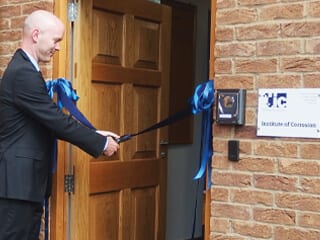
Latest News
It has been a long time since ICorr has had a permanent home of its own. After a long search for suitable premises in Northampton and 2 near misses, a suitable property was finally located by Trevor Osborne, who then supervised the purchase of 5 St Peter’s Gardens.
The new premises have been redesigned and fitted out to a high standard, to include modern office space for the office manager and staff, a conference room and a training floor with a flexible teaching layout, kitchen and breakout areas.
All the work involved in this process, from liaising with the local council, hiring an Architect and Contractors and overseeing the conversion work, has been personally handled by Trevor, without charging the Institute – a rare act of generosity in the modern world.
The office staff, Denise Aldous (Office Manager) ably assisted by Gwynneth and Sue, moved the office files, library and many ancillary items into the building and settled in the ground floor.
An ICATS training course has been successfully run in the new first floor training room and the presenter and attendees were impressed by the high standard of the facilities. The Trustees and the Council of the Institute have also held their first meeting in the bright meeting room on the second floor, and again were very pleased with the new facilities.
The official opening of the building took place on 6th June 2019 on a bright summer’s day, when the current President, Gareth Hinds, cut the ribbon with many ICorr members, Past Presidents and friends of the Institute in attendance.
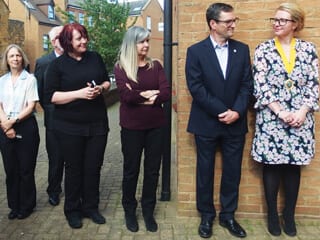
Gywnneth, Sue and Denise with David Mobbs and Immediate Past President, Sarah Vasey.

The President, Gareth Hinds performing the opening ceremony.
Everyone then moved up to the meeting room, and Bill Cox explained that this was the second building that ICorr had owned. The first was organised by David Deacon, and the Trustees of ICorr thought it was fitting that the meeting room be named the Deacon room in recognition. Bill presented the name plate for the room to members of David Deacon’s family, who were present to accept the accolade.
The entire group then moved down to the first floor training room, where Sarah Vasey, the Immediate Past President, spoke about the long search to find the current home for ICorr and the enormous efforts made by Trevor Osborne to make it the reality we were all experiencing. In recognition of his selfless work, the Trustees had agreed that the training room would be named the Osborne room. Sarah then presented the name plate to a surprised and delighted Trevor.
The final ceremony of the day was the signing of a new agreement for training, between ICorr and IMechE. Chris Kirby was present for IMechE and Sarah and Gareth for ICorr.
Following the formal part of the proceedings, the guests continued to enjoy an excellent buffet, whilst Gareth gave a presentation on the bright future of the Institute, followed by time for people to meet up with old friends and enjoy the event.
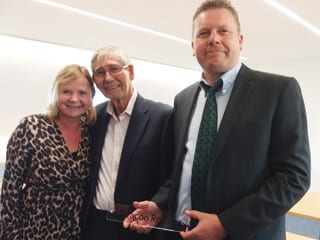
SallyAnn, David’s daughter, John Stringer, David’s brother in law, and his son Wil Deacon.
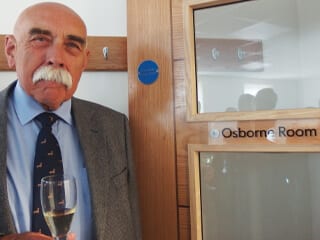
Trevor Osborne.
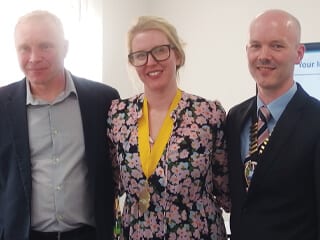
Chris Kirby, Sarah and Gareth.
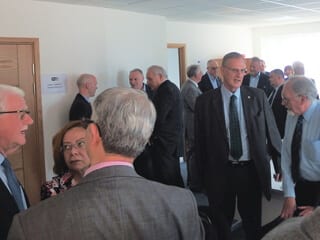
Guests enjoying the opening event.
At a time of perhaps greater than usual uncertainty about the future in the UK, the opening of the new building was a special occasion to recognise both the past and the new phase in the life of the Institute of Corrosion.
Jane Lomas
